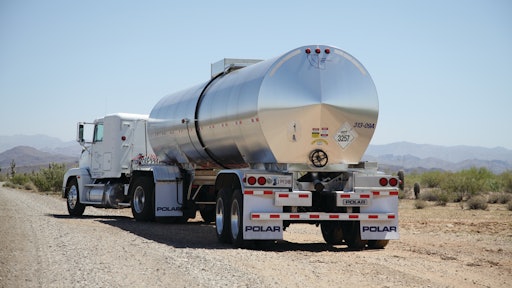
A pound saved is a penny earned when you’re hauling hot asphalt. The lighter your equipment, the more product you can legally load in one trip. The more product you can load, the more money you can make.
“That’s the bottom line,” says Sean Davis, president of Tri State Transportation in Phoenix. “We want to be able to haul the biggest net payload in the market.”
Tri State operates 25 tractor-trailers hauling liquid asphalt from refineries and terminals to highway paving jobs in Arizona, Nevada, and California. With heavier engines and emissions hardware adding weight to tractors, Davis says the trailer is the key to meeting his goal of high payloads and low tare weight. His trailer of choice: a tandem-axle, 7,500-gallon, aluminum hot-product trailer from Polar Tank.
The 42.5-foot trailer weighs just over 9,000 pounds and can scale 28.5 tons of liquid asphalt.
“That kind of capacity gives me a huge edge over a competitor who maxes out at 25 or 26 tons,” Davis says. “A job that takes the other guy nine trips I can do in eight and save both time and the operating costs associated with the extra shipment. Or I can bring the customer another load so he can pave more roadway that day.
“Over a day, a week, a month, a year - my trailers are going to far exceed the productivity, profitability, and return on investment my competitors’ will get from their trailers.”
Saving weight & time
The Tri State spec begins with a straight, round barrel with 0.249-inch aluminum on the bottom and 0.219-inch aluminum on the top and sides. It has fiberglass insulation, a belly-wrapped 0.032-inch aluminum jacket with lapped seams, and 0.063 aluminum heads lock-seamed to the jacket.
Pretty straightforward. The weight savings come from a range of aluminum and other lightweight components, including an aluminum undercarriage; Hendrickson AANT23K Intraax suspension with integrated axles; Accuride 22.5 x 8.25 aluminum polished disc wheels; and 255/70R Goodyear tires.
Polar helped Davis evaluate the characteristics of various materials and determine how each component contributes to the trailer’s payload capacity, durability, and driver convenience or safety. “Cutting weight can make sense, but you can take it too far,” says Davis, who saw his share of aluminum truck and trailer components while growing up working at his family’s West Coast construction business.
“With our Polars, we went down to the fine details to come up with the right balance,” he explains.
Demanding operations
Tri State runs hard - 24 hours a day, seven days a week, on the highway and on water-truck-maintained roads - so its equipment has to hold up. One Polar trailer logged 400,000 miles during the first 18 months of service.
When you’re spec’ing for low tare weight, durability is a combination of materials and manufacturing, says Ted Fick, president and CEO of Polar Corp. Polar is vertically integrated, meaning it builds many of the components used on its tank trailers. The result, says Fick, is greater quality control, less dependence on purchased parts, better integration of components, and more flexibility with product design and modifications. “We can custom-engineer liquid and dry bulk trailers to exacting customer specifications,” he explains.
One example: Polar repositioned the fenders on Tri State’s trailers to be more in proportion with the ultra-low-profile wheels. “Cosmetically, Polar tied everything together,” Davis explains. “It may seem like a little detail, but I want the trailer to look good even with those skinny tires.”
Other features are designed to save time and mess, like the trailer’s insulated aluminum breathing vent. It eliminates the surge and overspill of product that can occur with a free-breathing cover.
Davis says “everything works better” on his Polar trailers, adding that the combination of uptime and the extra payload wins bids for his company.
“I got a call at 4 in the morning from a customer asking if I could bring him 225 tons,” Davis recalls. “I said, ‘Sure, when does the job start?’ He said, ‘Now. The other company can’t do nine loads and isn’t showing up.’ It turned out I had only eight trucks available. But after the eighth load, the customer had his 225 tons plus one to spare.
Davis says he has customers who have never shipped such a large payload in one trailer. Customers have asked his drivers to make sure they pull the whole vehicle onto the scale when it’s already on there. “They love the productivity,” says Davis. “Customers can’t believe how much product we can haul.”


























